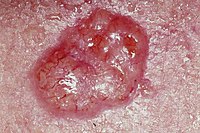
Photo from wikipedia
The rapid qualitative assessment of surface markers on cancer cells can allow for point-of-care prediction of patient response to various cancer drugs. Preclinical studies targeting cells with an antibody to… Click to show full abstract
The rapid qualitative assessment of surface markers on cancer cells can allow for point-of-care prediction of patient response to various cancer drugs. Preclinical studies targeting cells with an antibody to “activated” matriptase conjugated to a potent toxin show promise as a selective treatment for a variety of solid tumors. In this paper, we implemented a novel technique for electrical detection of proteins on surfaces of cancer cells using multi-frequency microfluidic impedance cytometry. The biosensor, consists of two gold microelectrodes on a glass substrate embedded in a PDMS microfluidic channel, is used in conjugation with immuno-magnetic separation of cancer cells, and is capable of differentiating between bare magnetic beads, cancer cells and bead-cell aggregates based on their various impedance and frequency responses. We demonstrated proof-of-concept based on detection of “activated” matriptase proteins on the surface of cultured Mantle cells.
Journal Title: Scientific Reports
Year Published: 2020
Link to full text (if available)
Share on Social Media: Sign Up to like & get
recommendations!